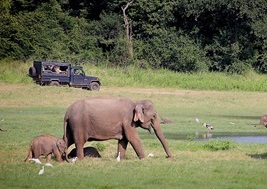Every single day, one elephant dies in Sri Lanka due to Human-Elephant Conflict (HEC), and it is escalating due to the unplanned alienation of land, clearing and fragmentation of forests, increased human settlements, and human encroachment into sensitive areas.
Sri Lanka has recorded 440 elephant deaths from January to November this year, exceeding the record for the highest number of elephant deaths in the space of a year – 439 in 2022 – in 11 months, according to Department of Wildlife Conservation (DWC) statistics.
Asserting that there is no “magic bullet” that can resolve HEC, Mr. Miththapala, called for a holistic plan to be implemented on multiple fronts and led from the very top of the government hierarchy.

“It is a complex problem that cannot be addressed piecemeal. A sustained, well-planned-out, and focused holistic plan has to be implemented on multiple fronts. This must be led from the very top of the government hierarchy to ensure compliance,” he emphasized, in an interview with Marianne David of The Sunday Morning.
An environmentalist, wildlife enthusiast, and tourism industry veteran with extensive knowledge of Sri Lanka’s elephants, Miththapala listed out areas such a plan should encompass, including a dedicated, high-level, full-time HEC task force with adequate powers to follow up and implement a plan agreed upon.
Miththapala also called for a halt to political interference in the management of wildlife and conservation, stating that most of the disruption of elephant movements and habitat shrinkage was due to land being given out to individuals purely due to political patronage. He stated:
“If we are to stem this ongoing carnage of this valuable natural asset Sri Lanka has been blessed with, immediate action must be taken.”
Following are excerpts of the interview:
According to statistics you’ve compiled based on DWC data, there have been 440 elephant deaths this year up to November alone, which exceeds the highest number of elephant deaths recorded in a year in Sri Lanka – 439 in 2022. In 2021, 375 deaths were recorded. At least one elephant dies in Sri Lanka every day. What’s going on?
I believe there are multiple reasons, including unplanned alienation of land (for agricultural and other use), clearing and fragmentation of forests, increased human settlements without any planning, and human encroachment (permanent or transient) into sensitive areas.
Essentially, there is less land available for elephants, resulting in their ranging patterns getting disturbed and bringing the elephants into more contact with people. Studies have indicated that close to 70% of wild elephants are outside the protected areas.
In 2022, the majority of the deaths were attributed to the HEC, which also claimed 146 human lives. This year 166 human deaths have been reported due to the HEC. What urgent steps need to be implemented to tackle the HEC and bring down the numbers?
There is no one “magic bullet” to resolve the HEC, unfortunately. It is a complex problem that cannot be addressed piecemeal. A sustained, well-planned-out, and focused holistic plan has to be implemented on multiple fronts. This must be led from the very top of the government hierarchy to ensure compliance.
This should include the following:
- Set up a dedicated, high-level, full-time HEC task force, with adequate powers, to follow up and implement a plan agreed upon.
- Stop political interference in the DWC.
- Stop all unplanned land alienation and encroachment.
- Provide financial support for community fencing for villages (where the entire area is enclosed within a properly designed electric fence maintained by the community itself.
- Build seasonal electric fencing around paddy and other agricultural plots.
- Impose increased fines and penalties on perpetrators of wildlife crimes.
- Create awareness about the need for conservation of nature for villagers.
- Speedy disbursement of compensation to HEC victims.
Gunshots killed the highest number of elephants in 2023, with 84 killed by shooting compared to 58 in 2022, while jaw bombs killed 43 elephants, 57 died due to electrocution (2022: 47), and 57 were killed in train accidents (2022: 14). There has been a significant rise in the numbers of shootings and train accidents. Why is this?
The overarching reasons are due to the aforementioned reasons. More specifically the reasons are as follows:
Shooting: mainly by villagers using shotguns to keep marauding wild elephants at bay. Most often these guns are not sophisticated and high powered, resulting in the elephant sustaining serious injuries, which aggravate over time, resulting in long-drawn-out suffering and eventual death. Of course the villagers also must be provided with some alternate solutions to prevent wild elephant encroachment. Properly located and designed electric fencing appears the best solution as of now. There are currently trials being conducted about a strobe light system to frighten the elephants away, but no definite results are available as yet.
Jaw bombs: These are traps set by the villagers to kill wild boar, where some fruit is laced with explosives, which is detonated by a pressure switch. Wild elephants accidently bite such traps, resulting in severe damage to their jaws and eventually leading to a gruesome death. These devices must be banned and those who use them must be fined heavily.
Train accidents: these are mostly confined to two or three stretches on the north and north eastern railway lines. Speed restrictions have not worked, partially due to non-compliance and also the difficult layout of the tracks, with several bends where early sightings are difficult to make. With today’s technology, an effective simple early warning system could easily be designed and tested if there is an effort from the relevant authorities.
Experts have warned that if this killing spree continues, elephants will go extinct in Sri Lanka in 25-30 years. According to the last count done by the DWC in 2011, the number of elephants in Sri Lanka was recorded as 5,800. What kind of numbers are we looking at in terms of elephant population at present?
Yes, there has been some talk about the waning population and the fear that the species will be wiped out. However, there is no proper study that has been done to support this.
Counting elephants is a complex task. No wild elephant census can give an accurate result. More than actual numbers, actual assessment of family groups, juveniles and adolescents, male-female ratios, and health and body conditions of individuals would be more useful for good scientific assessment of the exact situation.
Shrinking elephant habitats and the blocking of elephant corridors – are these avoidable or preventable?
As explained earlier, political interference in the management of wildlife and conservation has to be stopped. Most of the disruption of elephant movements and habitat shrinkage is due to land being given out to individuals purely due to political patronage without any reference to a long-term plan.
The “Elephant Gathering” in Minneriya has seen dwindling numbers over the last few years, with a 95% drop in 2021. How was the Elephant Gathering this year? Were adequate grasslands available in Minneriya and the recommended water levels maintained? Did the elephants show signs of malnutrition?
The numbers of wild elephants at the Gathering did come down due to the enhanced water levels in the Minneriya reservoir from the discharge of water from the Moragahakanda water supply scheme, which was recently commissioned.
The higher water levels restricted the growth of the grassland along the banks, on which the large number of wild elephants feed. Some elephants did show signs of malnutrition and several deaths of calves were also reported.
As of now there has been some agreement with the Irrigation Department to release water only during specific periods when the grasslands will not be affected. This has shown positive results this year, where larger numbers were prevalent at the Gathering.
The National Action Plan for the Mitigation of HEC proposes three approaches – seasonal agricultural fencing around paddy tracts, community-based fences around villages, and relocating of electric fences along ecological boundaries. What are your thoughts on these approaches?
All of these are excellent propositions, but the challenge is in the actual implementation of these actions, which is a malady that affects all areas of government. If the aforementioned high-level task force is set up, this could be implemented at least to some extent.
Is the National Policy for the Conservation and Management of Wild Elephants in Sri Lanka still relevant and has it been implemented?
Yes, very much so. Currently the President has appointed a committee to oversee the implementation of the action plans. Certainly this committee is doing what it can under the circumstances. However what is needed, as explained earlier, is a full-time task force with all authority and resources to ensure implementation.
If we are to stem this ongoing carnage of this valuable natural asset Sri Lanka has been blessed with, immediate action must be taken (on this basis), giving it the utmost priority.
(eTN): Elephant Carnage in Sri Lanka Requires Immediate Action | re-post license | post content























